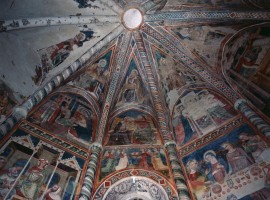
The church, located on the square of St. Francis, is a part of the monastery complex site on the northwest edge of the historic center. From historical sources that the Church was built starting in 1247 and finished in its original Romanesque – Gothic style, in 1303 (the date placed on the access portal recover in what is today the sacristy). In 1660 the church was renovated and underwent a total transformation…
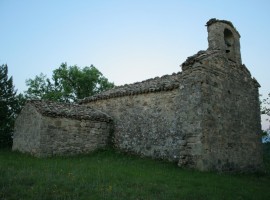
The thirteenth-century Church of St. Emidio is located in the hamlet of Ficocchia in the municipality of Comunanza. Built in stone “sponga” and sandstone, which has nineteenth-century interventions, and within retains traces of frescoes in the apse and walled arches; the coverage is sometimes stone.
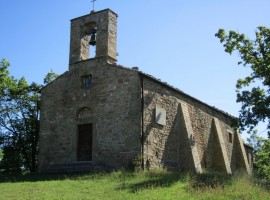
The Church of Santa Maria Assunta one finds in the hamlet of Polverina in Comunanza. The Church stands alone on a hill, it existed as early as 1290, but its present appearance is dated 1632. Inside you can admire a fresco depicting “The Annunciation of the Virgin” by Giulio Vergari of Amandola (XVI century). The bell tower houses a bell of the eighteenth century, of great importance for the local population because…
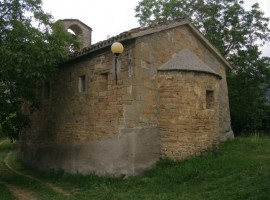
The Church of St. Agatha is located in the hamlet of Valentina Comunanza. Sant’Agata was a martyr of Catania, protector of women who are breastfeeding. It ‘a longitudinal plan, with a barrel vault. The interior of the seventeenth century but there is evidence much older
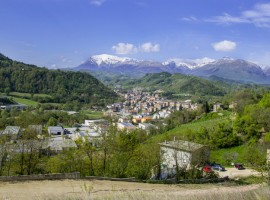
The Church of St. Anthony is located in the hamlet of Vindola in Comunanza. The church was built with the material recovered from the other oldest church of the same name outside the walls, after that, in 1861, the suppression of religious orders, and the confiscation of their goods, they took her to ruin.
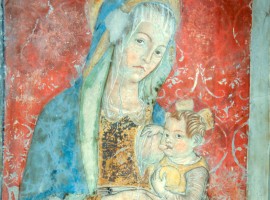
Dating from the period Farfense, it is more aisles, divided by columns supporting vaults. The church has two remarkable frescoes: the first attributed to Vittorio Crivelli (XV sec.). Depicting “The Madonna of Humility” or “Milk” between St. Augustine and St. Peter, the second by Vincenzo Pagani with the “Virgin with Child and Saints “including St. Rocco and St. Sebastian. The most notable is a “Pieta” sculpture in polychrome terracotta of Nordic art…
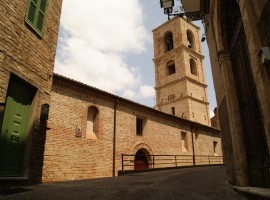
The Church of Santa Maria del Borgo called Templar Gothic, shows, in the present structure dates back to centuries. XIV, two magnificent “portals” on the facade that runs along via Margherita, characterized by brick cornices with geometric decorations. The left portal, which is the entrance, is topped by a panel with T (TAU), the symbol of the cross used in the Middle Ages and hired by the powerful Military Order of the…
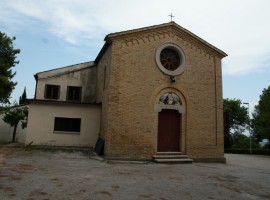
The Sanctuary of San Bernardino of Siena is in the countryside in the hamlet of Castiglioni. Once called “Castro Leone” belonged to the Diocese of Ascoli. Near the sanctuary there was a church of the XIV century, dedicated to San Francesco al Gallo, now completely destroyed. You do not know the date of the erection of the parish of Santa Maria della Pieve, but there archival document of 1599. On July 14,…
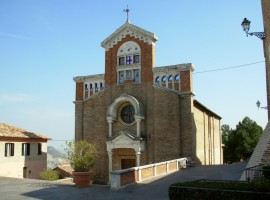
In the church of Santa Maria in the square below the castle, in a special glass case placed under the main altar, it is exposed the Holy Cross, which for centuries was the simulacrum most revered by all the inhabitants of Ripaberarda. Besides the priceless religious and devotional we are facing a great artifact art Ascoli fifteenth century gilded silver representing both the Crucifixion with the Virgin at the ends, an angel…
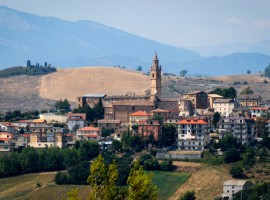
The Belfry is a perfect work of Ripaberarda Romanesque – Renaissance terracotta octagonal, decorated with spire, arches, floors tiled in blue, whose impressive building (some 52 meters) dates back to 1518 and is attributed to Antonio da Lodi.